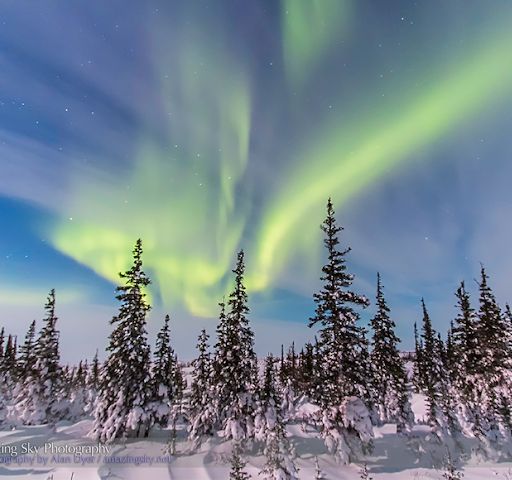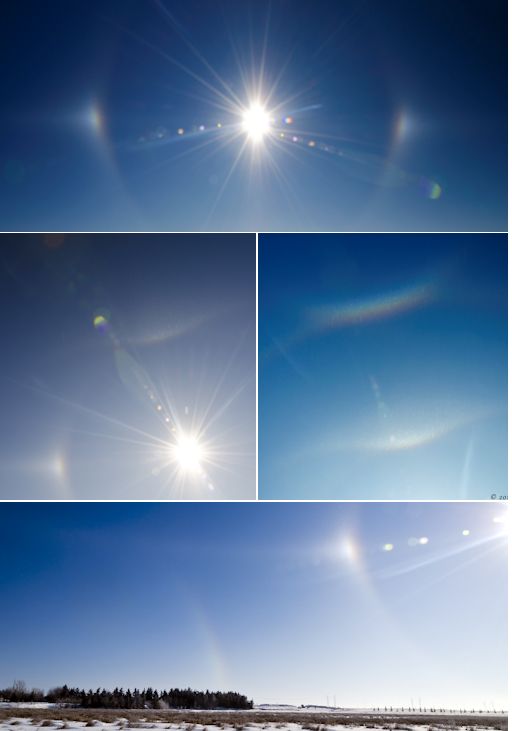EDGE OF SPACE VALENTINE'S CARD: It's heavenly, it's romantic, and most of all it's experimental. We're talking about an Edge of Space Valentine's Card! If you would like to have a picture of your choice photographed 120,000 feet above Earth's surface, submit your graphic and a $49.95 flight fee today. The student balloonists of Earth to Sky Calculus will fly it to the stratosphere on Feb. 11th. If all goes as planned, you'll have the photo back in time for Valentine's Day. Money back guarantee if it doesn't work Email Dr. Tony Phillips for details.
ROMANTIC AURORAS: The Moon will be full on Feb. 14th, and what could be more romantic than full moonlight on Valentine's Day? The answer is moonlit auroras:
"This is what we saw on Sunday, Feb 9th from the Churchill Northern Studies Centre on the shore of Hudson Bay in Manitoba," says photographer Alan Dyer. "With the bright waxing Moon, auroras now have to be even brighter than usual to show up in our sky.'
Bright auroras are dancing around the Arctic Circle as Earth passes through a 450 km/s stream of solar wind. If the display continues for a few more days, Arctic couples will have a lovely view. Aurora alerts: text, voice
'MAGICAL' ICE HALOS OVER CALGARY: On Sunday, sky watchers around Calgary, Canada, witnessed a magnificent display of ice halos around the sun. "It was magical--the best I've ever seen," reports photographer Dee Cresswell, who needed four exposures to capture all of the glowing arcs:
"The temperature was around -22 C, with a windchill in the mid minus thirties," she continues. "You could actually see the ice crystals shimmering in the air. There was a 22° halo, a 46° halo, infralateral arcs, tangent arcs, circumzenithal arc, a parhelic circle and more."
Atmospheric optics expert Les Cowley created a diagram labeling the halos: click here. He says they were created by a special kind of ice crystal called "diamond dust."
"Diamond dust--that is, low level ice crystals shaped as hexagonal plates and columns--make the very best halos because the crystals are large and of good optical quality," explains Cowley. "Plates made the bright sundogs and the circumzenithal arc while column crystals generated the upper tangent arc and the rarer supralateral and infralateral arcs. More peculiarly oriented columns gave the not often seen Parry arc. A few randomly tilted crystals produced the faint 22-degree halo and only a hint of the 46-degree circle. Supralateral arcs and the rarer 46° halo can be hard to tell apart."
"Even though wintry diamond dust is the king of halos,ordinary ice crystals in high clouds can give fine displays all year long," he says. "No matter where you live, or what time of year, keep an eye out for halos."

Solar wind
speed: 425.1 km/sec
density: 0.1 protons/cm3
explanation | more data
Updated: Today at 1726 UT
X-ray Solar Flares
6-hr max: M1 1652 UT Feb11
24-hr: M1 1652 UT Feb11
explanation | more data
Updated: Today at: 1700 UT
![]()
Daily Sun: 11 Feb 14
Sunspots AR1974 and AR1976 have 'beta-gamma' magnetic fields that harbor energy for Earth-directed M-class solar flares. Credit: SDO/HMI
![]()
Sunspot number: 122
What is the sunspot number?
Updated 11 Feb 2014
Spotless Days
Current Stretch: 0 days
2014 total: 0 days (0%)
2013 total: 0 days (0%)
2012 total: 0 days (0%)
2011 total: 2 days (<1%)
2010 total: 51 days (14%)
2009 total: 260 days (71%)
Update 11 Feb 2014
The Radio Sun
10.7 cm flux: 161 sfu
explanation | more data
Updated 11 Feb 2014
![]()
Current Auroral Oval:
Switch to: Europe, USA, New Zealand, Antarctica
Credit: NOAA/POES
![]()
Planetary K-index
Now: Kp= 1 quiet
24-hr max: Kp= 4 unsettled
explanation | more data
Interplanetary Mag. Field
Btotal: 4.4 nT
Bz: 2.1 nT north
explanation | more data
Updated: Today at 1550 UT
![]()
Coronal Holes: 11 Feb 14
There are no large coronal holes on the Earthside of the sun. Credit: SDO/AIA.






